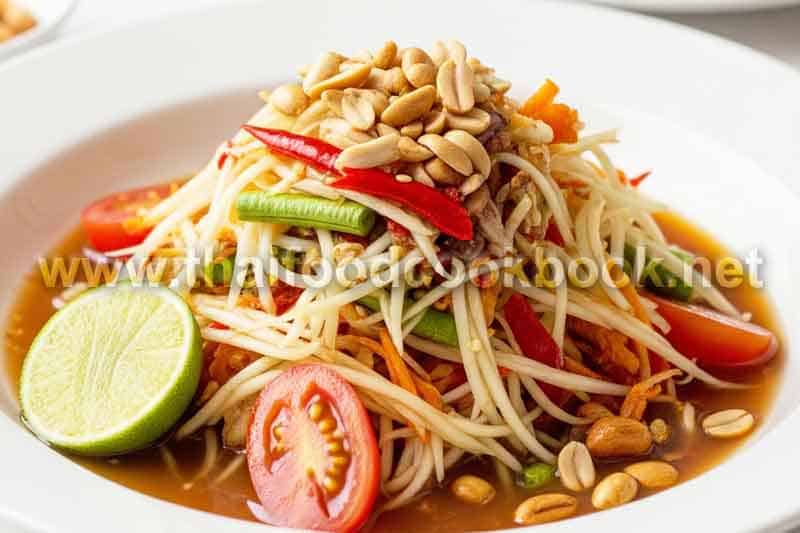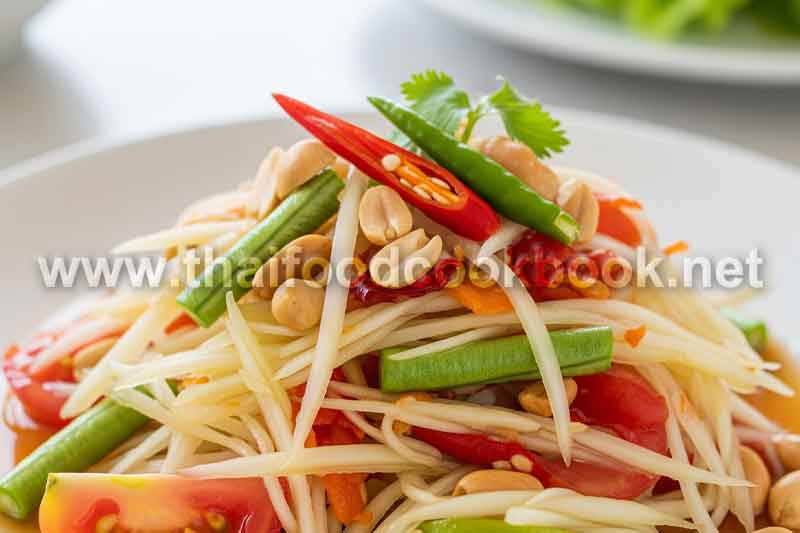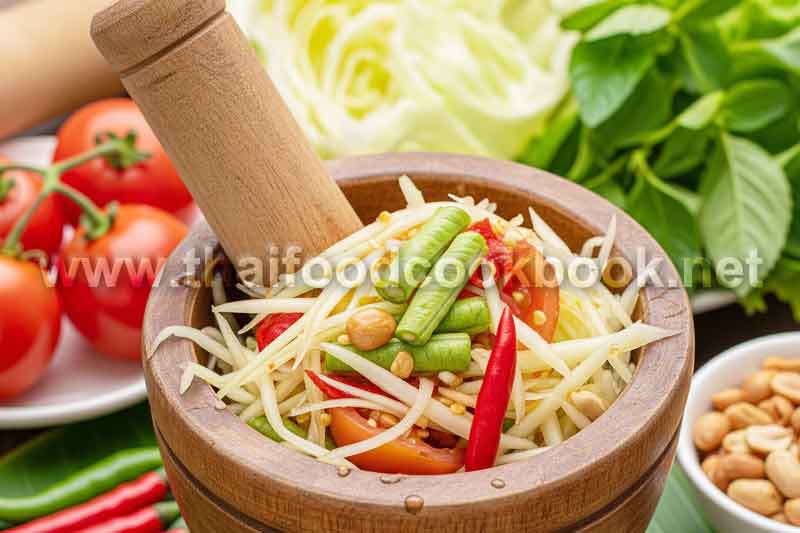What Is Som Tum? The Spicy Thai Papaya Salad Everyone Loves
What Exactly Is Som Tum?
Som Tum, often translated as “spicy green papaya salad,” is a cornerstone of Thai culinary tradition and represents the soul of Thai street food culture. The dish’s name originates from two Thai words: “som,” meaning sour, and “tum,” which refers to the pounding technique used in preparation. The result is a bright, flavor-packed salad made from shredded green (unripe) papaya, which brings a crisp texture perfect for soaking up spicy, tangy, and sweet flavors. It’s commonly made using a mortar and pestle, a method that helps meld the ingredients into a balanced explosion of taste.
Originally hailing from Thailand’s northeastern Isaan region, Som Tum has become a favorite not only throughout Thailand but also globally. Today, it can be found in Thai restaurants across continents and has won over hearts with its vibrant profile. Som Tum’s signature combination of chili heat, lime tang, umami from fish sauce, and mellow sweetness creates an unforgettable experience. Whether you’re a seasoned Thai food lover or a first-time taster, Som Tum leaves a lasting impression with every bite.
What Ingredients Are in Som Tum?
What makes Som Tum truly magical is its powerful harmony of ingredients. The core component is green papaya—firm, unripe, and shredded into thin, noodle-like strips that maintain a refreshing crunch. This forms the canvas for the rest of the dish. Crushed garlic and Thai bird’s eye chilies provide a spicy kick, while palm sugar and freshly squeezed lime juice balance sweetness and sourness. Fish sauce rounds out the mix with a deep, salty umami layer, pulling all the flavors together.
Additional ingredients include sliced tomatoes and chopped long beans for color and freshness, and roasted peanuts for nuttiness and texture. Many versions incorporate dried shrimp for a savory boost or fermented crab (in Som Tum Pu) for a richer, more pungent dimension. The method of pounding each ingredient together in a mortar not only integrates the dressing but slightly bruises the vegetables, releasing their natural juices and enhancing the flavor complexity. Every bite carries a crunch, a zing, and a satisfying contrast of textures and tastes.
How Spicy Is Som Tum?
Som Tum is known for its bold heat—but how spicy it is really depends on who makes it. In its native Thailand, it’s not uncommon to see vendors adding several bird’s eye chilies per serving. This can make the dish extremely hot by Western standards. However, Thai street vendors and chefs usually tailor spice levels to their customers’ preferences, especially for tourists. You can simply say “mai phet” (not spicy) or “phet nit noi” (a little spicy) to adjust the intensity to your liking.
Even when fiery, Som Tum doesn’t burn without purpose. The heat is beautifully tempered by the cooling crunch of the papaya and the sweet and tangy dressing, making it invigorating rather than overwhelming. Many first-timers begin cautiously with fewer chilies but quickly grow to crave the spicy rush. This flexible spice level is one of the reasons Som Tum is so popular with a wide audience—it’s easy to personalize, and its flavor always feels fresh, vibrant, and exciting.
Variations of Som Tum
Thailand’s rich culinary diversity is reflected in the many versions of Som Tum available across regions. The most well-known version, Som Tum Thai, is typically made with peanuts, dried shrimp, and a slightly milder chili count, making it accessible to newcomers. In contrast, Som Tum Pla Ra uses fermented fish sauce, lending a bold, earthy aroma that is beloved in the Isaan region. Som Tum Pu adds salted crab to the mix, introducing a briny, oceanic element that adds depth and complexity to the dish.
Contemporary adaptations are also widely enjoyed, especially in urban areas and among health-conscious diners. Some versions substitute the green papaya with fruits like green mango, apple, or even cucumber. Others incorporate salted egg for richness or adjust the seasoning to be vegetarian or vegan by swapping fish sauce for soy sauce or mushroom sauce. These variations showcase the dish’s adaptability and continued evolution while preserving its soul: the perfect balance of contrasting flavors and textures.
Where to Try Som Tum
There is no better place to experience Som Tum than on the streets of Thailand. Vendors prepare it to order in bustling markets, with ingredients laid out fresh and colorful. In cities like Bangkok, Chiang Mai, and Khon Kaen, it’s common to find entire stalls dedicated to Som Tum alone. It’s usually served with sticky rice, grilled chicken, or pork, forming a full meal that’s satisfying, affordable, and packed with flavor. Watching the vendor pound your salad fresh in front of you adds to the sensory appeal and ensures you get your preferred spice level.
Outside of Thailand, Som Tum remains a menu favorite at Thai restaurants around the world. From New York to Melbourne, chefs trained in traditional Thai cuisine keep the dish authentic, using imported or locally sourced ingredients. If you’re feeling adventurous, Som Tum is also fun and easy to make at home. Many Asian supermarkets carry green papaya, fish sauce, and palm sugar. Just be sure to invest in a good mortar and pestle—it’s the secret to unlocking the dish’s true flavor.
Why the World Loves It
Part of Som Tum’s universal appeal lies in its freshness, flavor complexity, and health benefits. It’s naturally low in fat, rich in fiber, and filled with vitamins from raw vegetables. With simple tweaks, it can also be made gluten-free, vegetarian, or even vegan. In an era where people seek flavorful, healthy food, Som Tum stands out as a delicious and nourishing choice that feels indulgent yet wholesome.
More than just a salad, Som Tum is a cultural experience. The act of preparing it—pounding, mixing, tasting—is interactive and rooted in Thai communal eating traditions. Whether enjoyed at a plastic table by a street cart or in a chic restaurant abroad, Som Tum embodies what makes Thai food so loved: bold flavor, joyful presentation, and a connection to place and people. Every plate tells a story of balance, hospitality, and culinary creativity.
Ready to Try Som Tum?
If you haven’t tasted Som Tum yet, you’re missing out on one of Thailand’s most iconic and flavorful dishes. Begin with a classic version to appreciate the authentic flavor, then branch out into regional specialties or creative twists. You’ll quickly see why this humble salad has captured hearts from Bangkok to Berlin.
Whether you’re exploring Thai food for the first time or adding another favorite to your recipe list, Som Tum is a dish that delights with every bite. So go ahead—find a Thai restaurant near you, or try making it yourself. Just don’t forget the chilies—unless you like it mild!


